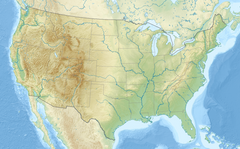|
FIS Alpine World Ski Championships 1950
Location in the United States Location in Colorado The FIS Alpine World Ski Championships 1950 were the 11th FIS Alpine World Ski Championships, held February 13–18 in the United States at Aspen, Colorado.[3] These were the first world championships held outside of Europe, and the first official world championships not concurrent with the Olympics since 1939. The Giant slalom made its world championships debut and displaced the combined event, which returned to the program in 1954 as a "paper race," using the results of the three races (downhill, giant slalom, and slalom) through 1980. At Aspen's Ajax Mountain,[4] Zeno Colò of Italy won the downhill[5] and giant slalom,[6] and just missed a sweep of the gold medals; he finished 0.3 seconds behind in the slalom, taking the silver. Austria dominated the women's races: Dagmar Rom won the giant slalom and slalom,[7] Trude Jochum-Beiser won gold in the downhill and silver in the GS, and Erika Mahringer took two silver medals, in the downhill and slalom. Aspen was in its fourth year as a ski area; it opened in December 1946 with a single chairlift. The Nordic world championships were also held in the U.S. in 1950, at Lake Placid, New York. Due to a lack of snow at Lake Placid, the cross-country events were moved to Rumford, Maine. Men's competitionsDownhillSaturday, February 18, 1950 In the final race of the championships, Colò descended the 2.1-mile (3.4 km) course
Giant slalom Tuesday, February 14, 1950 In the first men's race, Colò averaged 40 mph (64 km/h) in the one-run event.
SlalomThursday, February 16, 1950 Georges Schneider edged Colò by three-tenths of a second over two runs.
Women's competitionsDownhillFriday, February 17, 1950 Trude Jochum-Beiser, 22, won the final women's event, averaging nearly 50 mph (80 km/h).
Giant slalomMonday, February 13, 1950 In the first race of the championships, Rom averaged 30 mph (48 km/h) in the one-run event.
SlalomWednesday, February 15, 1950 Rom, 21, won her second gold medal in as many events by the slimmest of margins over two runs.
Medal Standings
VideoReferences
External links
|
||||||||||||||||||||||||||||||||||||||||||||||||||||||||||||||||||||||||||||||||||||||||||||||||||||||||||||||||||||||||||||||||||||||||||||||||||||||||||||||||||||||||||||||||||||||||||||||||||||||||||||||||||||||||||||||||||||||||||||||||||||||||||||||||||||||||||||||||||||||||||||||||||||||||||||||||||||||||||||||||||||||||||||||||||||||||||||||||||||||||||||||||



